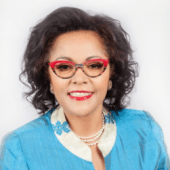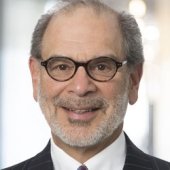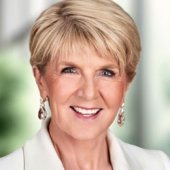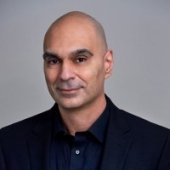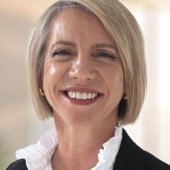Heidi Crebo-Rediker on future-proofing your business amid geopolitical risks
IN BRIEF
- "My first piece of advice would be if you are not paying attention to geopolitical, and I would extend to political risk, this can impact your business, and now is the time to start."
- "It begins with the board. Integrating geopolitical risk and how you determine what spillovers and disruptions may occur and embed it into the oversight mandate. You do need board members, or at least advisors with the right background who can ask the right questions."
- "I think the innovation’s really boundless and I think it’s been democratized in terms of its accessibility to unlock human potential even with younger people right now leading the way."
Joe Kornik sits down with Heidi Crebo-Rediker to discuss how business leaders can future-proof their business amid geopolitical risks. Credo-Rediker has held senior leadership positions in both in government and business, providing advice on geo-economics and international economic policy for two U.S. presidents. She is a former CEO and currently a Partner at International Capital Strategies, an Executive Vice President at America’s Frontier Fund, and an Adjunct Senior Fellow at the Council on Foreign Relations.
In this interview:
1:28 – Why pay attention to geopolitical risk?
6:38 – Prioritizing of issues: A national security lens
11:11 – Integrating economics with geopolitics
14:10 – Public-private partnership: A Venn diagram
18:20 – The world in 2035 and beyond
Heidi Crebo-Rediker on future-proofing your business amid geopolitical risks
Joe Kornik: Welcome to the VISION by Protiviti interview. I’m Joe Kornik, Editor-in-Chief of VISION by Protiviti, our global content resource examining big themes that will impact the C-suite and executive boardrooms worldwide. Today, we’re supporting the future of government, and I’m thrilled to welcome in Heidi Crebo-Rediker. Heidi has held senior leadership positions in both government and business, providing advice on geo-economics and international economic policy for two U.S. presidents. She served on the Biden Treasury Department transition team as lead on internation affairs, and previously in the Obama Administration as the state department’s first chief economist, where she provided guidance to two secretaries of state on the intersection of finance and geopolitics. She is a former CEO and currently a partner at International Capital Strategies, an executive vice president at America’s frontier fund, and an adjunct senior fellow at the Council on Foreign Relations. Heidi, thank you so much for joining me today.
Heidi Crebo-Rediker: Thank you so much for the invitation to join you.
Kornik: Heidi, you have such a unique background with extensive public and private sector experience on a global scale. So, your perspective here will be really valuable, I think. We’d all agree that we’re in a pretty tumultuous time right now, and navigating that, I think, will be challenging. So, what’s your advice to business leaders for future-proofing their business against geopolitical risks and sort of disruption that’s sort of happening all around us right now?
Crebo-Rediker: So, that is a great question, Joe. I guess my first piece of advice would be if you are not paying attention to geopolitical, and I would extend to political risk, this can impact your business, and now is the time to start. I guess the second point I would make, piece of advice, is to be proactive. If you’re going to future-proof, you need to be proactive and not reactive. Scenario plan and make it the job of the board and the management. This is something that outside of government I’ve been doing for the past 10 years or so with International Capital Strategies. It’s a healthy exercise.
So, just going back to the first point on why? Why pay attention? When we came out of COVID, we are facing a hot war in Europe, in the Middle East, and both took place very, very quickly. It took a lot of companies and countries by surprise, and there have been big ramifications for supply chains and commodity prices and energy security and transition, insurance costs, and relationships between companies and countries as a result. Again, we’re also facing tension in the South China Sea, in the Taiwan Straits, and we are deep into arising strategic competition between the U.S. and China. So, the result is really, there’s some big structural changes that we’re already seeing in the flows of goods and capital and trade relationships, and this architecture is going to continue to change. It’s playing out now and it will play out over the next decade.
We all know that concentration risk makes companies vulnerable and resilience and diversification of supply chains and of service providers can actually lessen the blow. Conflicts not only result in sudden disruptions, but they also can be followed on with sanctions and export controls and investment restrictions and the like. So, these are forced reactions. I think that brings me to my second point, which is that you can get ahead of this. In being proactive and not reactive. The way that I would recommend doing this is really to scenario plan. You can’t really model for geopolitical risk. It involves looking into the future and looking around corners and being smart about the way you plan for the different scenarios of what could happen. Then you can start to prepare how your company would respond to each one. I think scenarios are powerful tools. They should be a habit, not just a one-off event. It’s a good habit because it enables you to challenge conventional wisdom and really protect both the board and management against groupthink.
I think scenario planning is not new. If you go back to Shell and the famous Shell scenarios, they’ve been doing this since the 1970s. Just developing visions of the future. I think because they’ve been dealing with geopolitical risks for a long time, it’s something that they’ve become very good at.
I would take the example of Russia’s brutal invasion of Ukraine. Most countries and companies really didn’t anticipate that Russia would invade Ukraine beyond the invasion of 2014. It was a real massive failure of imagination and planning for the unthinkable because there was a lot of signals in that, in that noise running up until the invasion. We were paying attention to it because the signals were very clear and we flagged that the invasion was imminent. Imagine the ramifications and the clients that we were working with got, to the best of their ability, their investments and also their people out. It’s really also, I think, a study in how both European countries and companies became overly dependent, eyes closed. They developed a vulnerable overdependence on Russia for energy. There was huge concentration risk. There was no scenario plan that this would happen. It was captured by groupthink and I think that’s what you want to try to avoid as a company.
It begins with the board. Integrating geopolitical risk and how you determine what spillovers and disruptions may occur and embed it into the oversight mandate. You do need board members, or at least advisors with the right background who can ask the right questions. It’s a lot about asking the right questions.
Kornik: As I mentioned, you served on the Biden Treasury Department transition team as lead on international affairs, helping build the sort of international economic policy team, crafting policy on economic security, China policy, supply chain resilience, as you mentioned, trade, energy, the IMF and more. I bring all those up because they’re all still, I think, really big issues right now. Which of those issues will require the most attention and action over the next several years and how should we be addressing them?
Crebo-Rediker: So, I think all of those areas and issues are important. I think maybe a more helpful exercise is to look at those issues through a framework or a prism. The prism I would choose is that national security is trumping commercial and economic interest, and that is the world in which we live right now. It’s not just the U.S. This is something that is very clear, the prism that China is using. The prism that Russia is using. Increasingly, you’re seeing countries, Japan, you’re seeing many countries in Europe actually looking at, taking a look through the national security prism. This plays out in supply chain resilience, in trade, in energy and energy security, and even through IMF programs. I think most clearly, it’s playing out in U.S.-China policy. We have better mood music right now. The direction of travel is quite clear regardless of who is going to be in the White House come January of next year. But, right now, I would not be as much distracted by the mood music and think about what the general trajectory of the relationship is. On the back of that trajectory, the U.S. has really reconfigured a lot of its economic security relationships. If you look at the Indo-Pacific, there’s new architecture that we’re creating with allies, likeminded countries. We’re creating new kind of sectoral partnerships, like the minerals, security partnership. It’s really focused on how the government, the U.S. government, is looking at its own supply chain resilience. Critical minerals and metals are necessary for energy transition and energy security, and they have defense applications as well. So again, it’s the national security prism.
The other thing I would say is there’s a potential for forced decoupling that could come about as part of the defensive agenda that countries have. The U.S., the G7, other likeminded countries, and it’s for several reasons. As I mentioned, we’re guarding against our own strategic vulnerability. Because we’ve also seen over the past, more than a decade, that China is a master of weaponization, of overdependence, and it’s part of their strategy. So, we need to be thinking like that as well. It’s not just critical minerals and metals. It’s also we have overdependence in pharmaceutical products. What we’ve seen with the Russian invasion is that we had overdependence on various types of food commodities, and so we saw food shocks.
The second is that I think we’re going to see a lot more protecting of strategic advantage. The U.S., we’ve already, we’ve seen for several years into the protection and increasing protection of critical and emerging technologies. I think this is a trend. I think there’s more to come. The White House has been very clear. It’s about advanced computing and microelectronics, quantum, artificial intelligence, and also, on their list, biotechnologies and biomanufacturing, and think about broadband. There are many different categories that we might want to be thinking about where we want to be protecting national security and how that might play out in commerce.
Kornik: Right. Right, and that sort of leads me right into my next question, which I mentioned in the intro that you served in the Obama Administration as the state department’s first Chief Economist where you provided strategic advice to Secretaries of State on the integration of economics and finance with geopolitics, right? I think that’s something that a lot of business leaders are sort of struggling with right now. So, what strategic advice would you give business leaders trying to sort of successfully navigate that integration between finance and economics with geopolitics?
Crebo-Rediker: So, one of the things, and looking back at that experience at the state department, you got to get out of your silo and make silo-crossing something that is part of an institutional culture. Because we live in a very complicated world, and convergence is a theme that we’re really seeing everywhere. In a time of rapid convergence, you don’t want to be stuck in a silo. So, institutionalizing, that is actually critical. That’s what we did at the state department for economic state craft. You had a department that was filled with immensely talented professionals that have deep national security talent. The idea was really to get them and encourage them to think differently about some of the economic and financial drivers of power and also of change that had implications for foreign policy across the institution. That included, at the time, financial crises, the rise of non-market state actors and the impact on global commerce.
At that time, we also were looking at the weaponization of energy and pipeline politics. So there were sort of those things that had clear national security implications. Then we also were thinking about the rise of economic tools. How can we create opportunity and sort of have a development of a positive economic statecraft, enterprise funds, as well as some of the more coercive tools like sanctions. We brought a lot of new talent in, but also it was really about getting everybody to think a little bit differently, getting them out of their comfort zones and crossing siloes.
I think the state department’s actually doing that right now with critical and emerging technology. Same thing that businesses are doing, society is doing. The tech innovation as a source of national power for the U.S., it’s increasingly foundational. So, every bilateral relationship and multilateral relationship, and every functional issue that the state department deals with, from climate change to human rights or arms control, there’s definitely a technology element that’s growing. So, business leaders need to drive the silo-crossing as an institutional priority. Bring in new talent, new perspective, and then this will feed back better into scenario planning.
Kornik: Right, right. You have such a unique perspective because you do have such vast experience in both the business world and the government world. Sort of the public and the private sector. How do you see those two most effectively interacting and intersecting in the future? What does the public-private sector Venn diagram, if you will, what does that look like?
Crebo-Rediker: The Venn diagram—I like that. I like the visual. I think the public-private sector Venn diagram is changing very quickly and it’s increasing the overlap between public and private. It’s ever more important. It’s directly related to what we’ve already discussed. I think it’s really, it’s the flipside and it’s the opportunity side, that industrial policy with all of the challenges that come along with managing that appropriately really presents the biggest opportunity. The opportunity that we see in the United States is this enormous invested home and with trusted partners because you’re looking at strategic resilience, not only with the U.S. but with allies and partners.
This investment is going to be ramping up over the next five to 10 years. I don’t think we’ve internalized, really, the scale and the ambition that these instruments and this funding is actually going to provide for the companies. Most importantly, interacting with the government with shared objectives. We can’t really do this the same way that a country like China would, because our strategic advantage really is our capital markets, our private investors, our innovative capacity that we see coming from companies. So, a lot of the programs that are industrial policy in nature are really designed to catalyze and take advantage of this private sector ability to innovate and invest.
The U.S. isn’t always—I mean, the government isn’t always the first place that you would think of to actually want to do business or better your investment strategy, but there are a lot of opportunities in this on-shoring and friend-shoring initiative. We see it’s not just in the U.S. We’re seeing this happen in the EU. We’re seeing it happen in Japan, and it’s a combination of using subsidies and tax incentives and grants and subsidized loans and loan guarantees and credit enhancements and sort of all the tools we can put in the toolbox. The approach has been one where it’s ecosystems and hubs. You can look at the way that the U.S. is trying to roll out some of these funds in the hydrogen space, in the computing space, quantum space. It’s a really different approach than anything we’ve done in the past.
There is a huge, huge investment, a big boost in investment in basic scientific research. Really the biggest that we’ve seen in the past 70 years. If you’re looking to invest abroad, developing markets are very highly supported through a new and expanded U.S. development finance corporation. They use a lot of the same instruments I just talked about but they also make direct equity investments, and that’s something very different when you look at the Venn diagram concept. U.S. direct investment in equity is something that we really, we haven’t seen particularly outside of the U.S. So, I guess there’d be—there will be tensions about how this Venn diagram grows and managing industrial policy in a market economy, but I think it really—it’s not only necessary but I think it’s a trend to watch if this is going to end up growing over time.
Kornik: Yes, very interesting. That brings me to my last question. I think I might have heard a little bit of optimism in there, so I’m excited about that. First of all, thank you for your time today. You’ve been very generous with your time. I’m going to leave you with one final question, and I’m going to ask you if you’re optimistic that we’ll get this right. Are you optimistic that we’ll be living in a better world, let’s say, a decade from now? Take me out to 2035 and tell sort of what you see for the planet.
Crebo-Rediker: So, a decade from now, I would say on balance, with the right checks and balances. I see us living in a more dangerous, but I would say, overall, a better world. Given that you’re talking about 2035, I actually, I’m most hopeful because I think that the younger generation inheriting these challenges and opportunities is really well-placed to take the baton and move forward and make the most optimistic outcome that we could envision.
I’m, by nature, an optimist. I start there and I actually see this particularly in technology and innovation and the velocity of change.
What we’ll see between now and 2035, you have to really use your wildest imagination. We’ll see a revolution in drug development, in healthcare delivery, in education and manufacturing. We might see huge scientific breakthroughs in how to tackle climate change. So I think the innovation’s really boundless and I think it’s been democratized in terms of its accessibility to unlock human potential even with younger people right now leading the way.
That’s if we get it right. So, you can’t not look at the downside because the downside risks are pretty daunting. Particularly given our topic today, which is geopolitical risk. The potential for these risks to be exacerbated and for technology, in particular, to change the future of warfare, autonomous warfare, accelerate weapons of mass destruction and divide societies. The world is filled with bad actors, both state and non-state actors, and they have unparalleled access to data and to cyberweapons. We’re already capable of shutting down critical infrastructure. So, this is not necessarily even looking 10 years down the future, but you just have to project where this could go. So, again, ending on an optimistic note, because I do think that on balance we will end with a better future, but we have to manage the downside risks.
Kornik: Right. Well, Heidi, thank you so much for your time today. I really enjoyed our conversation. Thanks so much for those insights.
Crebo-Rediker: Thank you for the invitation this week.
Kornik: Thank you for watching the VISION by Protiviti interview. On behalf of Heidi Crebo-Rediker, I’m Joe Kornik, we’ll see you next time.
Did you enjoy this content? For more like this, subscribe to the VISION by Protiviti newsletter.





